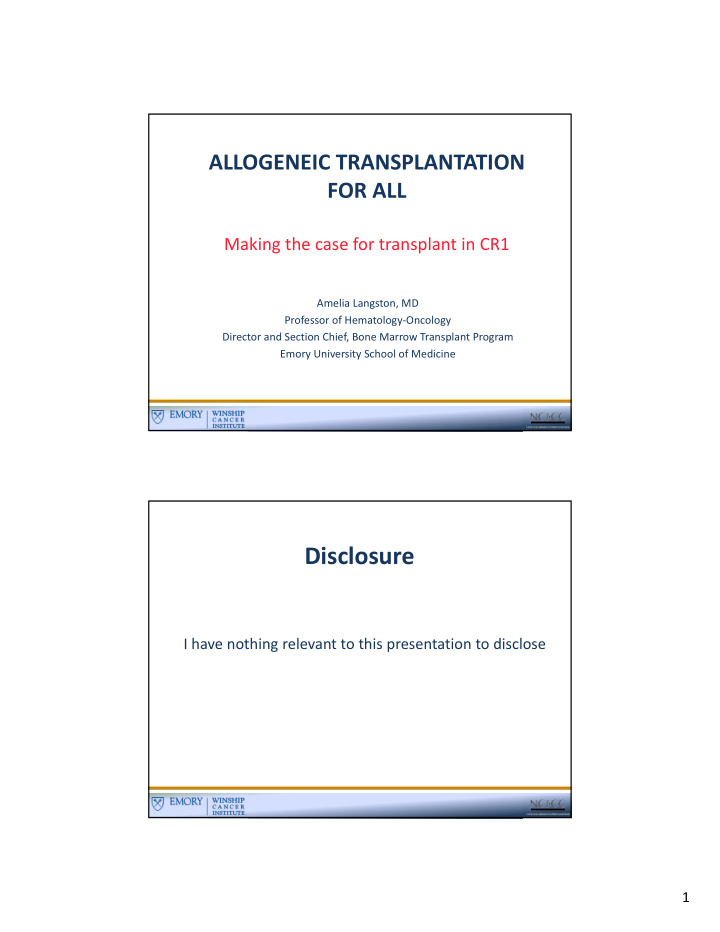



ALLOGENEIC TRANSPLANTATION FOR ALL Making the case for transplant in CR1 Amelia Langston, MD Professor of Hematology ‐ Oncology Director and Section Chief, Bone Marrow Transplant Program Emory University School of Medicine Disclosure I have nothing relevant to this presentation to disclose 1
Allogeneic Stem Cell Transplantation for ALL Balancing the risks and benefits… •TRM •Late complications Disease control What is Dr Khoury going to say? • ALL is not one disease…so one size fits all is not the answer • Modern techniques for detection of minimal residual disease (MRD) allow a risk stratified approach to who needs a transplant • Novel salvage strategies offer the promise that we can get more relapsing patients into CR2 and on to transplant 2
What am I going to say? • There is no such thing as a good risk adult ALL • Transplant remains our most powerful therapy for ALL • Transplant is much safer (and more widely applicable) now than it was 20 years ago • Available data as well as mathematical models support offering transplant to adults with ALL in CR1 if a matched donor is available and the patient is fit 3
2000-2004 Improvements in 1980-84 outcome diminish with increasing age D Pulte et al. Blood 2009 Ph ‐ negative ALL 4
Study Design AH Goldstone et al. Blood 2008 5
92% 72% “compliance” “compliance” AH Goldstone et al. Blood 2008 Standard chemotherapy was superior to autologous transplantation AH Goldstone et al. Blood 2008 6
Patients with a donor had superior overall survival Patients in no donor arm censored at the time of autoSCT AH Goldstone et al. Blood 2008 Standard risk patients derived the greatest benefit from transplantation due to more NRM in the high risk cohort High risk definition – Age > 35 yrs – WBC ≥ 100,000 for B lineage – WBC ≥ 30,000 for T lineage ALL AH Goldstone et al. Blood 2008 7
Life beyond relapse? Only 18% of pts made it to transplant 5 year survival post relapse was only 7% for the group as a whole AK Fielding et al. Blood 2008 8
Limitations of UKALLXII/ECOG 2993 • Chemotherapy program was not as intense as that used in most centers today, particularly considering that many younger pts receive pediatric ‐ like regimens • Donor + arm received only myeloablative transplants from matched related donors – What about RIC and nonmyeloablative regimens, esp. for older pts? – What about matched unrelated donors? AH Goldstone et al. Blood 2008 Meta-Analysis of Adult ALL studies Transplant vs no Transplant in CR1 J Pidala et al. Cochrane Collaboration, 2006 9
Decision Analysis of HSCT vs Chemo for ALL in CR1 S Kako et al. Leukemia 2010 What about Ph+ ALL? 10
UKALLXII/ECOG 2993 bridged the imatinib era AK Fielding et al. Blood 2014 Post ‐ remission therapy in the imatinib cohort Allo ‐ transplant still produces the best outcomes AK Fielding et al. Blood 2014 11
MRD status assessed by PCR at CR is highly predictive of remission duration in pts treated with a TKI + HCVAD and not transplanted in CR1 F Ravandi et al. Blood 2013 What about donor type—can we extrapolate existing data to include well matched unrelated donors? 12
Matched related donor and matched unrelated donor transplants in ALL ‐ CR1 produce similar outcomes MG Kiel et al. JCO 2004 Conclusions • There is no such thing as a favorable risk adult with ALL • Adults with ALL and a matched donor benefit from transplantation • Few pts who relapse ever make it to transplant in CR2 13
NO PAIN NO GAIN 14
Recommend
More recommend